
-
Hitta rätt mat för ditt husdjurGör det här testet för att se vilket foder som kan vara bäst för din pälskling.Hitta rätt mat för ditt husdjurGör det här testet för att se vilket foder som kan vara bäst för din pälskling.Utvalda produkter
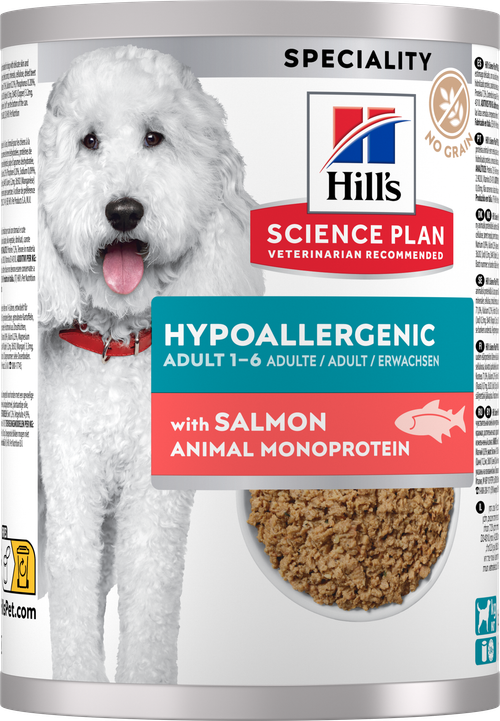 Hypoallergenic Adult Hundfoder
Hypoallergenic Adult HundfoderHILL'S SCIENCE PLAN Hypoallergenic Adult hundfoder med lax är ett helfoder för vuxna hundar 1–6 år gamla. Det är framtaget för hundar med känslig hud och mage, med ett begränsat antal högkvalitativa, nya proteinkällor & utan spannmål.
Handla nu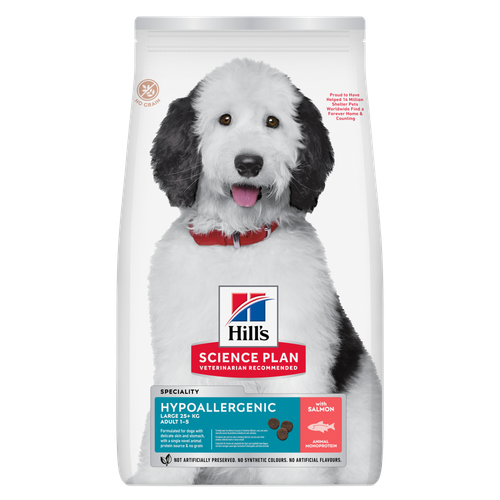 Hypoallergeniskt hundfoder för vuxna hundar med lax
Hypoallergeniskt hundfoder för vuxna hundar med laxHILL'S SCIENCE PLAN Hypoallergenic Large Breed Adult hundfoder med lax är ett komplett foder för vuxna hundar av stora raser i åldern 1–5 år. Det är särskilt framtaget för hundar med känslig hud och mage, med begränsade mängder högkvalitativa och nya proteinkällor samt utan spannmål.
Handla nu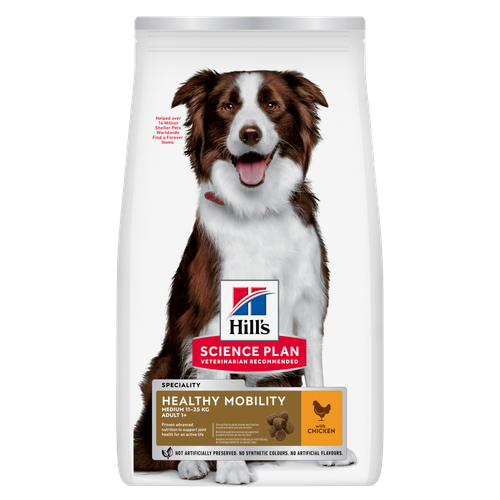 Healthy Mobility Medium Adult Hundfoder
Healthy Mobility Medium Adult HundfoderHill's Science Plan Healthy Mobility Medium Breed Adult Hundfoder med kyckling erbjuder en avancerad nutrition för att stödja ledhälsa och förbättra rörligheten. provides advanced nutrition to support joint health and improve mobility.
Handla nuHälsotillståndUtvalda produkter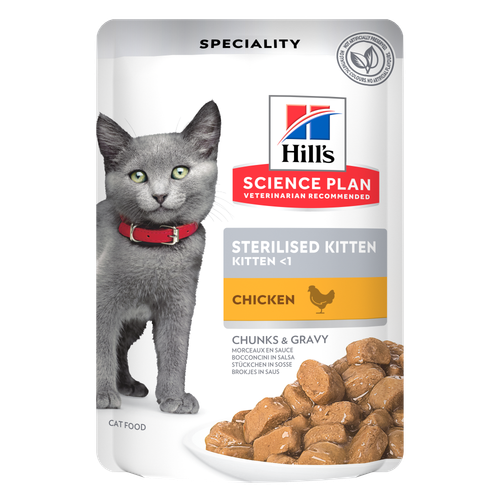 Sterilised Kattungefoder
Sterilised KattungefoderHill's SCIENCE PLAN Sterilised Kitten kattungefoder är skapat med Hill´s unika förståelse för de specifika behov som kastrerade kattungar har. Det bidrar med hög proteinkvalitet för muskelutveckling, med kontrollerat fett för att förebygga risk för övervikt efter kastrering. Dessutom har det en unik blandning av antioxidanter för att främja ett hälsosamt immunsystem för att stöjda din kattunges tillväxt.
Handla nu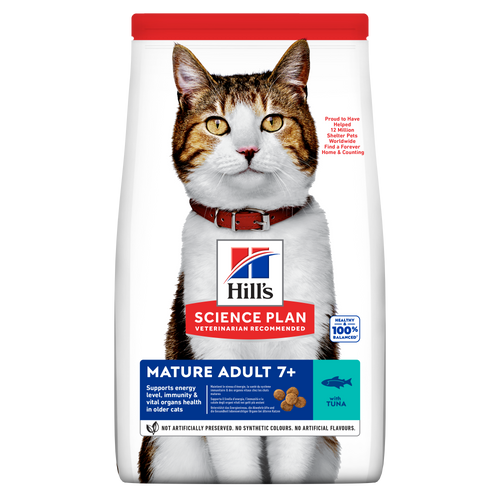 Hill's Science Plan Mature Adult Kattfoder Tonfisk
Hill's Science Plan Mature Adult Kattfoder TonfiskHill's Science Plan Adult kattfoder med lax är ett helfoder för äldre katter, speciellt utformat med ActivBiome+ Multi-Benefit teknologi.
Detta foder främjar ett värdigt åldrande hos katter och innehåller en synergistisk blandning av ingredienser som bidrar till att upprätthålla energi- och aktivitetsnivån.Handla nu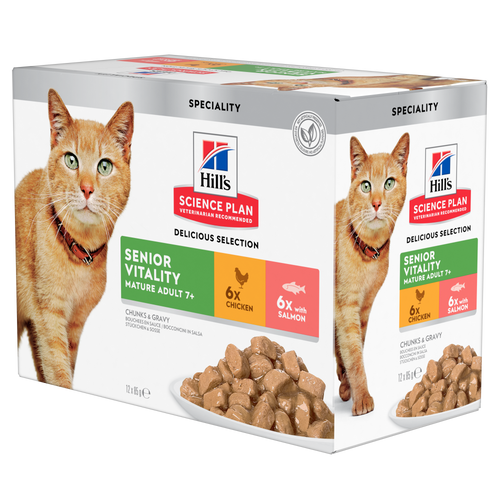 Hill's Science Plan SENIOR VITALITY KATTFODER Kyckling, med laxHandla nu
Hill's Science Plan SENIOR VITALITY KATTFODER Kyckling, med laxHandla nu -
Till hundägare
- Tips och artiklar
-
Hälsokategori
- Vikthantering
- Miljö- och foderöverkänslighet
- Urinvägar
- Matsmältning
- Leder
- Njurar
-
Hundens livsstadium
- Näring för valpar
- Näring för vuxna katter
- Näring för seniorer
Till kattägare- Tips och artiklar
-
Hälsokategori
- Vikthantering
- Hud- & foderöverkänslighet
- Urinvägar
- Matsmältning
- Njurar
-
Kattens livsstadium
- Näring för kattungar
- Näring för vuxna
- Näring för seniorer
Utvalda artiklar Kristaller och stenar i hund- och katturin
Kristaller och stenar i hund- och katturinLäs om orsaker till och behandlingar av kristaller i hund- och katturin för att bibehålla hundens eller kattens hälsa. För expertråd om urinvård, besök Hill's Pet Sverige.
Läs mer Viktförändringar hos hundar och katter - kan det vara ett sköldkörtelproblem?
Viktförändringar hos hundar och katter - kan det vara ett sköldkörtelproblem?En viktförändring kan tyda på ett problem med sköldkörteln. Läs mer om tecken, orsaker och vad du kan göra åt det.
Läs mer Virtual Vet Visits: What You Need to Know
Virtual Vet Visits: What You Need to KnowLearn the ins and outs of a televet appointment before you talk to a vet online.
Läs mer -


Cat dermatitis is a common condition that leads to itching, redness, and skin irritation. There are lots of things that can cause skin issues in cats, from fleas to food allergies, and many conditions share similar signs and symptoms. Because of this, skin diseases can be very challenging to diagnose. One such condition is cat allergic dermatitis. Prevention, where possible, and early diagnosis are important factors in cat dermatitis. Here, we’ll explain the common causes, signs and symptoms so that you can get your cat an accurate diagnosis and the best treatment.
Causes of cat allergic dermatitis
Cat allergic dermatitis refers to a skin condition caused by an allergen. Some of these allergies can also manifest themselves in other ways, such as vomiting and diarrhoea or respiratory signs. Just like humans, cats can get asthma associated with allergies. The four most common causes of allergies in cats are:
1. Flea allergy
Flea allergic dermatitis, or FAD, is very common in cats. Cats become allergic to the flea’s saliva, which is injected into the skin when the fleas feed. In sensitive cats, just one or two bites can cause severe irritation. In turn, this can lead to secondary infection, where bacteria from the skin are able to get into the cat’s system through self-inflicted scratch wounds in the skin. Fleas tend to prefer to stay around the tail base and head and neck, so if a flea allergy is the problem, you’ll often notice that signs such as hair loss and scabs are more concentrated in those areas.
It doesn’t take a serious flea infestation to cause signs in an allergic cat, so you may never actually see a flea on them. Fleas spend most of their time in the soft furnishings of the house and just hop on to feed, so you can’t rule out FAD if you don’t see them. A good way to spot the presence of fleas is to look for flea dirt in your cat’s fur. This is flea poo and is made up of digested blood. Comb your cat’s fur onto a white piece of kitchen roll and moisten any blackish specks you see with a drop of water. If it’s household dirt or mud, it won’t change colour, but flea dirt will leave a red stain as the blood soaks into the paper.
2. Atopy
Atopy is an allergy to things in the environment, such as dust mites, storage mites, pollens, grasses, trees, etc. Over time, cats can become allergic to one or several of these environmental allergens. In the case of seasonal allergens, like pollen, signs could only show at certain times of year, while other allergens, like dust, can cause problems year-round.
Atopic dermatitis tends to appear in young cats under the age of five, but it can occur in older cats, too.
Atopy tends to cause irritation around the head, neck and ears and the belly, flanks and legs. It is also a cause of otitis (inflamed ear canals). As well as skin symptoms, inhaled environmental allergens like pollens can also cause asthma in cats.
3. Food allergy or intolerance
Adverse food reactions (AFRs) in animals may be a “true” allergy, with an immune reaction to a certain protein, or an intolerance, which isn’t a true allergy. The most common food allergens in cats are chicken, dairy, fish and wheat. Food allergies will cause year-round skin symptoms, and you may also see gastrointestinal symptoms as well, such as vomiting, or more commonly, diarrhoea.
4. Contact allergies
Just as it sounds, some allergies occur when your cat comes into contact with something. This could be bedding washed in a certain washing powder or things like plastic food bowls. The signs of contact allergies will vary depending on where the contact is. Signs of irritation and hair loss round the chin are common with food bowl allergies, while other areas of the body may be affected by other chemicals or allergens depending on the point of contact.
Signs and symptoms of cat allergies
Cats are great at keeping their fur and skin in tip-top condition, so a healthy cat should have fur that is shiny, well-kept and lustrous. Signs of many skin diseases, including cat allergic dermatitis, can range from mild to severe and include:
Mild signs
Hair loss
Excessive grooming
Itching, scratching, licking or rubbing
Hair balls, because your cat is grooming more than usual and ingesting excess fur
Moderate signs
Flaky or scaly patches
Bad skin odour
Red patches, spots or pimples
Severe signs
Scabs, crusts or thickened skin
Eosinophilic granulomas. Eosinophils are a type of white blood cell involved in allergic reactions. In cats with severe allergies, you may see bright-red plaques or masses full of these cells on the skin. They often look very inflamed and angry.
Moist dermatitis or pyoderma. This is often secondary to other skin problems and due to the cat traumatising their own skin due to itchiness. Secondary bacterial infection sets in and this can be very problematic to treat. Cats get into a vicious cycle of itching and self-trauma.


Smakrika tips
Kattungar kan behöva flera besök under sitt första år för vaccinationer. Vuxna katter har i allmänhet nytta av årliga kontroller, medan seniorkatter eller katter med särskilda behov kan behöva mer frekventa besök.
How is cat allergic dermatitis diagnosed?
As we mentioned at the beginning, lots of skin diseases cause similar symptoms, so your vet will need to do tests to rule certain conditions in or out. These may include skin scrapes to look for parasites, hair plucks to check for fungal infections like ringworm, biopsies, food trials, blood tests and/or intradermal skin testing.
A flea allergy is usually diagnosed by the presence of the classic distribution of scabs and itchiness, and by the presence of flea dirt that we mentioned earlier.
Atopy is usually diagnosed after ruling other things out and doing a blood test or intradermal testing to find out what allergens are triggering your cat.
If a food allergy is suspected, your vet will want to do an elimination trial. Your cat will be given a special therapeutic food. This may be one that is hydrolysed, which means that the proteins are broken down into such small pieces that the body doesn’t recognise them as allergens. Alternatively, it may be a diet with a novel protein, such as duck or venison, that your cat has not eaten before. It is incredibly important that your cat eats only this food for the length of the trial, which may be up to 12 weeks.
As you can see, skin disease in cats needs a methodical approach when it comes to diagnosis. It can be time-consuming and costly, so be prepared and always consider pet insurance. Please be patient with your vet and their team while they try to get to the bottom of your cat’s problem.
Treatment and prevention of cat dermatitis
Treatment and prevention will vary depending on the cause of your cat’s allergic dermatitis. Also bear in mind that some cats can have more than one of these kinds of allergies so may need various strategies.
Flea allergy. Very strict flea control with effective products is usually a relatively easy fix for flea allergic dermatitis. If your cat has broken, inflamed skin due to excessive scratching, they may also be given a course of antibiotics and possibly some steroids to help stop the itching. Your vet may also recommend treating your house to get rid of any fleas that are hiding in the soft furnishings.
Using these effective flea treatments regularly, as recommended by your vet, should prevent fleas setting up house with you and keep your cat comfortable. Your vet may also recommend preventatively treating your house once or twice a year. Regular vacuuming also stimulates eggs to hatch and will allow the young fleas to be killed.Once you have identified your cat’s allergens, you can then have a specific ‘vaccine’ tailor-made for these allergens. This is called immunotherapy and it works by administering tiny doses to start with, then very gradually increasing them over months. The aim of this is to desensitise your cat to the allergens.
Obviously, anything you can do to reduce exposure is also useful in prevention of flare-ups, such as eliminating storage mites or getting rid of house plants that may be a trigger. Immunotherapy has a good response in around 70-80% of cats.Once you have finished your food elimination trial, you have a couple of options – your vet may suggest you reintroduce your cat to various foods, one at a time, to see what the trigger is, or you may decide to just stick with the therapeutic food if you obtain a great result.
In summary
It’s important to remember that some cats can have more than one skin issue going on at a time. And the underlying cause may be complicated by secondary infections and self-trauma. As we said, please be patient with your vet while they work through the process of getting to the bottom of your cat’s skin disease. Always complete courses of treatment that you are given. If you’re ever unsure, just ask your vet to clarify why they opted for that course of action.
Even if your cat is not allergic to food, your vet may recommend changing to a food that is designed to help cats with any skin disease. These foods help bolster the skin barrier function and keep it strong. They have essential fatty acids in them to keep skin healthy and reduce inflammation, along with added anti-oxidants to help reduce cell damage.
Many skin issues can have a great outcome with patience and good teamwork. Hopefully, your cat will soon be itch-free and back to their lustrous, beautiful selves.
FAQs
What are the first signs of cat dermatitis?
The earliest signs of cat dermatitis are usually overgrooming, scratching and hair loss.Is cat dermatitis contagious?
Allergic dermatitis is not contagious, but some skin problems caused by certain parasites can be contagious to other pets and humans. If you or your family have any skin changes, talk to both your vet and doctor.Can stress cause skin problems in cats?
Yes, a common cause of cat hair loss is stress-induced or psychogenic alopecia. You can read more about that here.What’s the best flea treatment for cats with skin allergies?
There are many flea treatments that are effective. Just follow your vet’s recommendation and never use products that do not say they are safe for cats.Can diet help improve my cat’s dermatitis?
In many cases, yes. Therapeutic diets for skin problems have certain ingredients which support skin health and function.
Reviewed by Dr. Hein Meyer, DVM, PhD, Dipl-ECVIM-CA and Dr. Emma Milne BVSc FRCVS.


En av våra skribenter förberedde den här artikeln åt dig
Relaterade produkter


Hill's Science Plan Adult kattfoder med lax är ett helfoder för äldre katter, speciellt utformat med ActivBiome+ Multi-Benefit teknologi.
Detta foder främjar ett värdigt åldrande hos katter och innehåller en synergistisk blandning av ingredienser som bidrar till att upprätthålla energi- och aktivitetsnivån.

Hill's Science Plan Perfect Digestion Foder till Kattungar med Kyckling & Fullkornsris ger näring åt din kattunges unika mikrobiom och hjälper dem att nå sin fulla potential.

Hill's SCIENCE PLAN Sterilised Kitten kattungefoder är skapat med Hill´s unika förståelse för de specifika behov som kastrerade kattungar har. Det bidrar med hög proteinkvalitet för muskelutveckling, med kontrollerat fett för att förebygga risk för övervikt efter kastrering. Dessutom har det en unik blandning av antioxidanter för att främja ett hälsosamt immunsystem för att stöjda din kattunges tillväxt.
Relaterade artiklar

Discover how to train your cat, starting with very basic first steps that both reward good behavior and discourage the bad. It
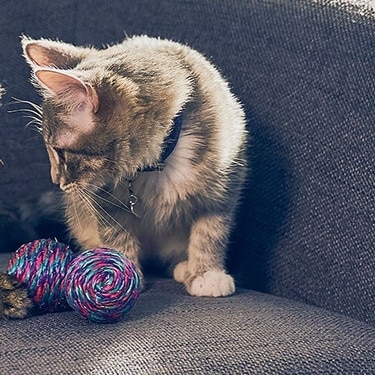
Are you looking to get your cat more active? Does she constantly look bored? Then you may want to consider using a food-dispensing (also known as treat-dispensing) cat toy, which provides both physical and mental stimulation during snack times.

Lär dig mer om orsakerna till hårbollar hos katter och upptäck effektiva behandlingar för att hålla din katt frisk. Besök Hill's Pet Sverige för fler råd om katters hälsa.

Upptäck roliga och engagerande spel för katter som även fungerar som bra motionskällor. Utforska spännande sätt att hålla din katt aktiv och underhållen!

Sätt din katt på diet utan att den märker det
Vår kalorifattiga sammansättning hjälper dig att kontrollera din katts vikt. Den innehåller högkvalitativt protein för att bygga slanka muskler och är tillverkad med noga utvalda ingredienser för en smakrik och näringsrik måltid. Kliniskt bevisade antioxidanter, vitamin C+E, bidrar till ett friskt immunförsvar.
Sätt din katt på diet utan att den märker det
Vår kalorifattiga sammansättning hjälper dig att kontrollera din katts vikt. Den innehåller högkvalitativt protein för att bygga slanka muskler och är tillverkad med noga utvalda ingredienser för en smakrik och näringsrik måltid. Kliniskt bevisade antioxidanter, vitamin C+E, bidrar till ett friskt immunförsvar.

